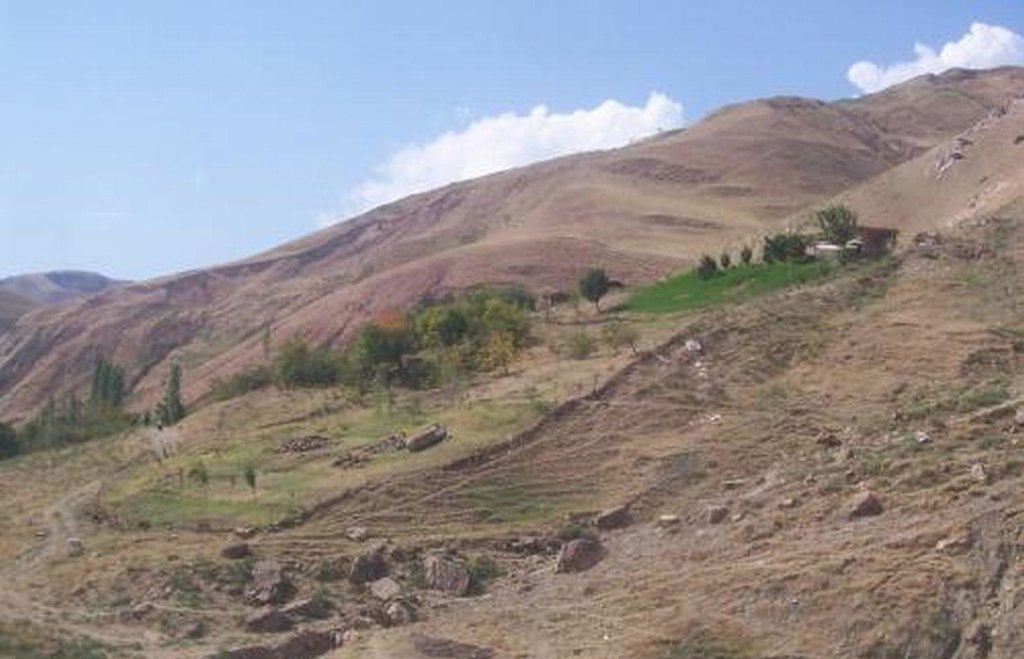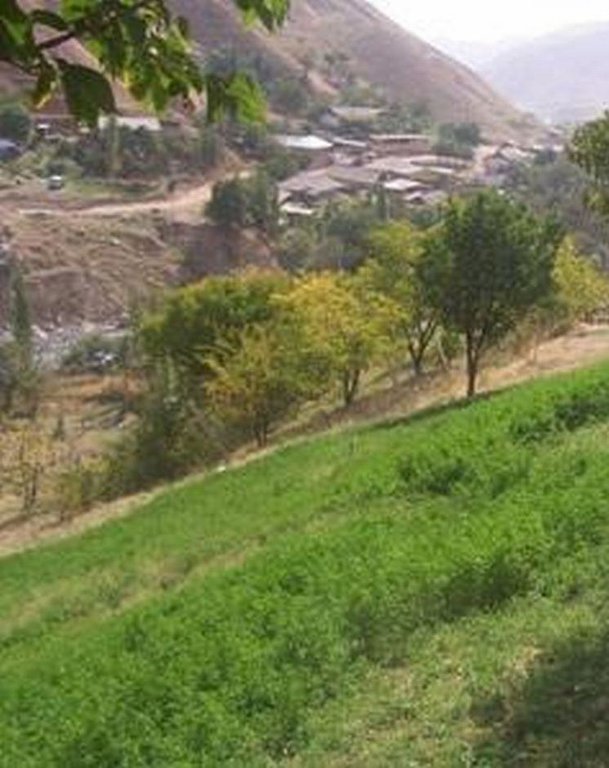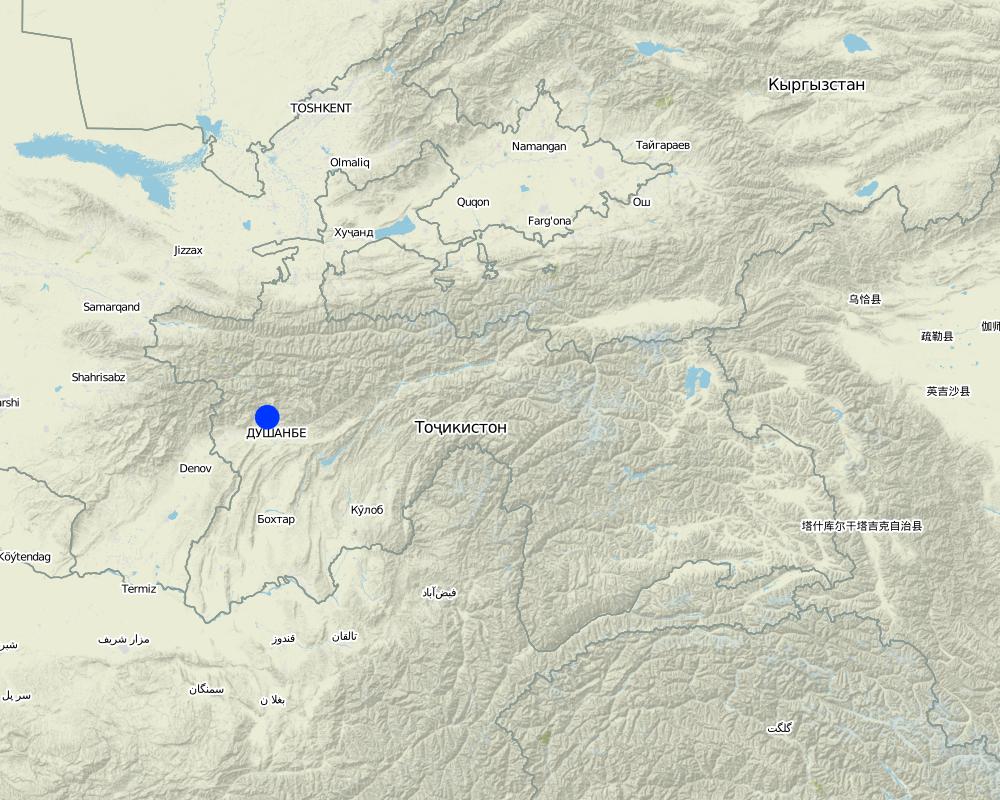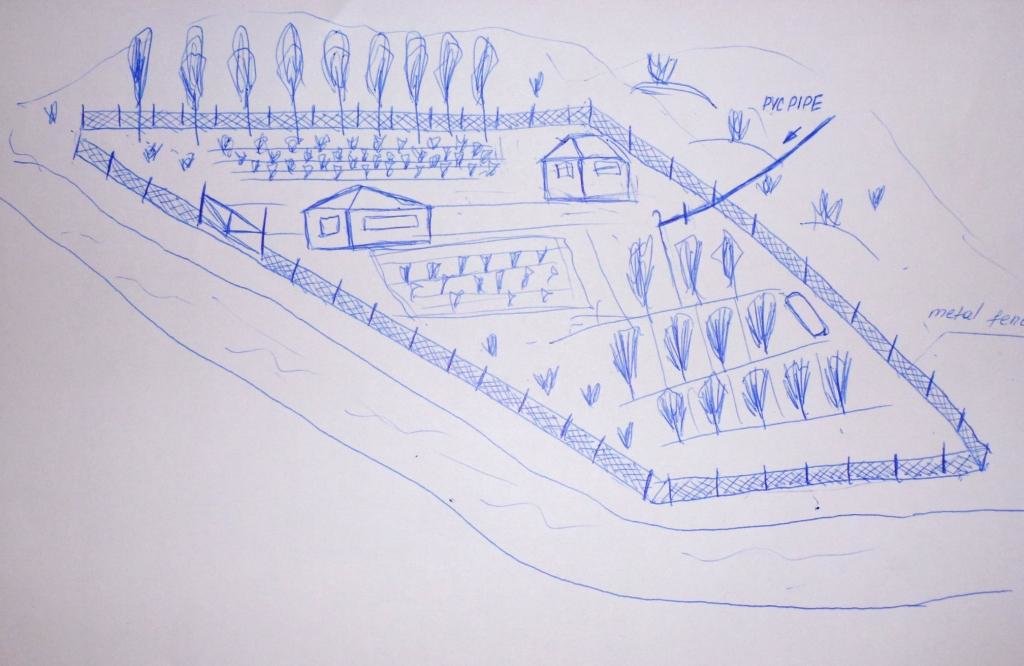Integrated Technologies for Household Plots [ทาจิกิสถาน]
- ผู้สร้างสรรค์:
- การอัพเดท:
- ผู้รวบรวม: Habib Kamolidinov
- ผู้เรียบเรียง: –
- ผู้ตรวจสอบ: David Streiff, Alexandra Gavilano
technologies_1057 - ทาจิกิสถาน
ดูส่วนย่อย
ขยายทั้งหมด ย่อทั้งหมด1. ข้อมูลทั่วไป
1.2 รายละเอียดที่ติดต่อได้ของผู้รวบรวมและองค์กรที่เกี่ยวข้องในการประเมินและการจัดเตรียมทำเอกสารของเทคโนโลยี
ผู้เชี่ยวชาญ SLM:
ชื่อขององค์กรซึ่งอำนวยความสะดวกในการทำเอกสารหรือการประเมินเทคโนโลยี (ถ้าเกี่ยวข้อง)
GITEC/ADB/DMC Rural Development Project Land Management Institute - ทาจิกิสถาน1.3 เงื่อนไขการใช้ข้อมูลที่ได้บันทึกผ่านทาง WOCAT
ผู้รวบรวมและวิทยากรหลักยอมรับเงื่อนไขเกี่ยวกับการใช้ข้อมูลที่ถูกบันทึกผ่านทาง WOCAT:
ใช่
2. การอธิบายลักษณะของเทคโนโลยี SLM
2.1 การอธิบายแบบสั้น ๆ ของเทคโนโลยี
คำจำกัดความของเทคโนโลยี:
A fenced enclosure transformed with stone clearing and a small scale irrigation system, to grow a wide range of perennial, annual and orchard crops, beekeeping and small scale animal production.
2.2 การอธิบายแบบละเอียดของเทคโนโลยี
คำอธิบาย:
A small area of previously severely eroded and almost devoid of vegetation area of land that was transformed through the building a perimeter fence, supplying a simple irrigation system and the planting of a diverse range of crops to provide a rich, integrated farming system. Activities then completed on this area included: orchard planting, perennial fodder crops (lucerne), garden vegetables, bee keeping for honey production and small scale animal rearing.
Purpose of the Technology: The farmer clearly stated that his prime, initial purpose in taking over this “ruined and abandoned land” was to improve and better guarantee the quality of his family’s lifestyle through enhanced and assured food and fodder production. He also recognised the potential for future profit through sale of his excess produce to market. Currently, the family has almost no need to buy food (and fodder) from nearby markets, apart from flour for bread making. This is a large cost saving. In hindsight, the farmer sees that he has dramatically improved land quality within the enclosure through mitigating erosion and increasing year-round vegetation cover.
Establishment / maintenance activities and inputs: The family (Enomali is the family name) first occupied this land in 1984. The first task was tree planting – a variety of orchard trees – on 0.1 ha of the current enclosure. This was fenced using abandoned wire and metal supports from old Russian factories. After nine family members left (to work in Dushanbe) the land user expanded the fence to the current 0.2 ha and continued to plant trees. He continued the stone removal through the 1990s and even up until the present day. Lucerne and vegetable gardens were initiated in the 1990s and continue to be enriched as required. Fodder, tree and vegetable production includes an ongoing set of tasks, as does the animal feeding with the home-grown fodder. Bee keeping is seasonal and the honey kept for home consumption. The land user continues to plant orchard trees every year and currently has more than 100. He gained a “certificate” of ownership” in 2008.
Natural / human environment: Before the family occupied this land, the land user stated that it was “totally ruined and abandoned”. That is why it was unoccupied. The family were prepared to work extremely hard to convert this ruined land to the green and productive “island” that it now is. The people in the area are dependent upon the produce of the land, however suitable land is in short supply and subject to population pressures.
2.3 รูปภาพของเทคโนโลยี
2.5 ประเทศภูมิภาค หรือสถานที่ตั้งที่เทคโนโลยีได้นำไปใช้และได้รับการครอบคลุมโดยการประเมินนี้
ประเทศ:
ทาจิกิสถาน
ภูมิภาค/รัฐ/จังหวัด:
Central District of Tajikistan
ข้อมูลจำเพาะเพิ่มเติมของสถานที่ตั้ง :
Varzob
ระบุการกระจายตัวของเทคโนโลยี:
- กระจายไปอย่างสม่ำเสมอในพื้นที่
If precise area is not known, indicate approximate area covered:
- < 0.1 ตร.กม.(10 เฮกตาร์)
แสดงความคิดเห็น:
The small area was all that the family could manage as there was an initial large workload, clearing stones and fence building, etc
Map
×2.6 วันที่การดำเนินการ
ถ้าไม่รู้ปีที่แน่นอน ให้ระบุวันที่โดยประมาณ:
- 10-50 ปี
2.7 คำแนะนำของเทคโนโลยี
ให้ระบุว่าเทคโนโลยีถูกแนะนำเข้ามาอย่างไร:
- ด้วยการริเริ่มของผู้ใช้ที่ดินเอง
ความคิดเห็น (ประเภทของโครงการ เป็นต้น) :
The land user developed the integrated approach to implentation of the technology.
3. การจัดประเภทของเทคโนโลยี SLM
3.1 วัตถุประสงค์หลักของเทคโนโลยี
- ปรับปรุงการผลิตให้ดีขึ้น
- rehabilitate severely degraded land
3.2 ประเภทของการใช้ที่ดินในปัจจุบันที่ได้นำเทคโนโลยีไปใช้
Land use mixed within the same land unit:
ใช่
Specify mixed land use (crops/ grazing/ trees):
- วนเกษตร (Agroforestry)

พื้นที่ปลูกพืช
- การปลูกพืชล้มลุกอายุปีเดียว
- การปลูกพืชยืนต้นที่ไม่มีเนื้อไม้
- การปลูกไม้ยืนต้น ไม้พุ่ม
Annual cropping - Specify crops:
- fodder crops - other
- vegetables, orchard fruits, lucerne
จำนวนของฤดูเพาะปลูกต่อปี:
- 1
ระบุ:
Longest growing period in days: 180Longest growing period from month to month: April to September

ทุ่งหญ้าเลี้ยงสัตว์
ทุ่งหญ้าเลี้ยงสัตว์ที่มีการจัดการแบบเข้มข้นหรือการผลิตอาหารสัตว์:
- ตัดแล้วขนไป / ไม่มีการปล่อยแทะเล็มเอง (Cut-and-carry / zero grazing)

ป่า/พื้นที่ทำไม้
ผลิตภัณฑ์และบริการ:
- ผลไม้และถั่ว
แสดงความคิดเห็น:
Livestock density (if relevant):
< 1 LU/km2
Major land use problems (compiler’s opinion): Massive water erosion causing gullies, sheet washing and landslides. This leads to land denudation of the soil and vegetation. Almost total lack of soil organic matter and above/below ground biodiversity. No water holding capacity of the land – combination of steep slopes and no vegetation causes all rainwater to immediately runoff.
Major land use problems (land users’ perception): Same – the above words were used by the farmer in the on-farm interview.
Cut-and-carry/ zero grazing: Yes
Other type of forest: orchard species
Forest products and services: fruits and nuts
Future (final) land use (after implementation of SLM Technology): Mixed: Mf: Agroforestry
3.3 Has land use changed due to the implementation of the Technology?
Has land use changed due to the implementation of the Technology?
- Yes (Please fill out the questions below with regard to the land use before implementation of the Technology)
Land use mixed within the same land unit:
ใช่
Specify mixed land use (crops/ grazing/ trees):
- วนเกษตร (Agroforestry)

ทุ่งหญ้าเลี้ยงสัตว์
แสดงความคิดเห็น:
Grazing land: Ge: Extensive grazing land
3.4 การใช้น้ำ
การใช้น้ำของที่ดินที่มีการใช้เทคโนโลยีอยู่:
- น้ำฝนร่วมกับการชลประทาน
3.5 กลุ่ม SLM ที่ตรงกับเทคโนโลยีนี้
- การปลูกป่าร่วมกับพืช
- การปรับปรุงดิน / พืชคลุมดิน
- การปรับปรุงพันธุ์พืชหรือพันธุ์สัตว์ต่าง ๆ
3.6 มาตรการ SLM ที่ประกอบกันเป็นเทคโนโลยี

มาตรการจัดการพืช
- A1: พืช/สิ่งปกคลุมดิน

มาตรการอนุรักษ์ด้วยวิธีพืช
- V1: ต้นไม้และพุ่มไม้คลุมดิน

มาตรการอนุรักษ์ด้วยโครงสร้าง
- S6: กำแพง สิ่งกีดขวาง รั้วไม้ รั้วต่างๆ

มาตรการอนุรักษ์ด้วยการจัดการ
- M1: การเปลี่ยนรูปแบบของการใช้ประโยชน์ที่ดิน
แสดงความคิดเห็น:
Main measures: agronomic measures, vegetative measures, structural measures
Type of agronomic measures: better crop cover, mixed cropping / intercropping, cover cropping, retaining more vegetation cover, furrows (drainage, irrigation)
Type of vegetative measures: in blocks
3.7 รูปแบบหลักของการเสื่อมโทรมของที่ดินที่ได้รับการแก้ไขโดยเทคโนโลยี

การกัดกร่อนของดินโดยน้ำ
- Wt (Loss of topsoil): การสูญเสียดินชั้นบนหรือการกัดกร่อนที่ผิวดิน
- Wg (Gully erosion): การกัดกร่อนแบบร่องธารหรือการทำให้เกิดร่องน้ำเซาะ
- Wm (Mass movement): การเคลื่อนตัวของมวลดินหรือดินถล่ม

การเสื่อมโทรมของดินทางด้านชีวภาพ
- Bc (Reduction of vegetation cover): การลดลงของจำนวนพืชที่ปกคลุมดิน
- Bh (Loss of habitat): การสูญเสียแหล่งที่อยู่
- Bq (Quantity/biomass decline): การลดลงของปริมาณหรือมวลชีวภาพ
- Bl (Loss of soil life): การสูญเสียสิ่งมีชีวิตในดิน
แสดงความคิดเห็น:
Main type of degradation addressed: Wt: loss of topsoil / surface erosion, Wg: gully erosion / gullying, Wm: mass movements / landslides, Bc: reduction of vegetation cover, Bl: loss of soil life
Secondary types of degradation addressed: Bh: loss of habitats, Bq: quantity / biomass decline
Main causes of degradation: deforestation / removal of natural vegetation (incl. forest fires) (Post Soviet era – massive forest clearing for firewood), over-exploitation of vegetation for domestic use (Exploitation of fire wood.), overgrazing (massive overgrazing of an already depleted land resource), other natural causes (avalanches, volcanic eruptions, mud flows, highly susceptible natural resources, extreme topography, etc.) specify (Loess landscape – highly susceptible to water erosion – massively exacerbated by vegetation clearing (tree chopping and animal grazing))
Secondary causes of degradation: population pressure, poverty / wealth, war and conflicts (increased natural resource pressure during the civil war.)
3.8 การป้องกัน การลดลง หรือการฟื้นฟูความเสื่อมโทรมของที่ดิน
ระบุเป้าหมายของเทคโนโลยีกับความเสื่อมโทรมของที่ดิน:
- ฟื้นฟูบำบัดที่ดินที่เสื่อมโทรมลงอย่างมาก
แสดงความคิดเห็น:
Secondary goals: prevention of land degradation, mitigation / reduction of land degradation
4. ข้อมูลจำเพาะด้านเทคนิค กิจกรรมการนำไปปฏิบัติใช้ ปัจจัยนำเข้า และค่าใช้จ่าย
4.1 แบบแปลนทางเทคนิคของเทคโนโลยี
ข้อมูลจำเพาะด้านเทคนิค (แบบแปลนทางเทคนิคของเทคโนโลยี):
The drawing shows an enclosed area, a fence line consisting of wire fencing, brush and scrap metal materials. At the top of the slope a row of fast growing poplars was planted to protect the enclosure and the adjacent vegetable plot from the wind and rain. Perenials are intercropped with fruit trees further below the dwelling and the area is fed by an irrigation pipe originating from a local spring.
Location: Tajikistan. Varzob, Luchob
Date: 28 April 2011
Technical knowledge required for field staff / advisors: moderate (If training was provided to replicate the technology.)
Technical knowledge required for land users: moderate
Main technical functions: control of raindrop splash, control of dispersed runoff: impede / retard, improvement of ground cover, improvement of topsoil structure (compaction), increase in nutrient availability (supply, recycling,…), increase / maintain water stored in soil, increase of biomass (quantity), promotion of vegetation species and varieties (quality, eg palatable fodder)
Secondary technical functions: increase of surface roughness, improvement of surface structure (crusting, sealing), increase in organic matter, increase of infiltration, water spreading, improvement of water quality, buffering / filtering water, reduction in wind speed, spatial arrangement and diversification of land use
Better crop cover
Material/ species: Perennial lucerne for fodder
Quantity/ density: 100% cover
Remarks: 0.1 ha
Cover cropping
Material/ species: Lucerne is a cover crop
Retaining more vegetation cover
Material/ species: Land previously bare
Agronomic measure: other
Material/ species: Perennial legume pasture species - lucerne
Quantity/ density: 0.1 ha
Furrows (drainage, irrigation)
Material/ species: Irrigation via hand cut 20cm cube ditches and poly pipe
Aligned: -contour
Vegetative material: T : trees / shrubs
Scattered / dispersed
Vegetative material: T : trees / shrubs
In blocks
Number of plants per (ha): 100%
Vertical interval between rows / strips / blocks (m): about 0.1 ha planted
Fruit trees / shrubs species: Apple, cherry, apricot, pear
Perennial crops species: lucerne
Other species: Vegetable garden
Slope (which determines the spacing indicated above): 38.30%
Gradient along the rows / strips: 5.24%
Wall/ barrier
Depth of ditches/pits/dams (m): 1
Length of ditches/pits/dams (m): 1000
Slope (which determines the spacing indicated above): 21 degrees – measured with cli%
Lateral gradient along the structure: 3 degrees%
ผู้เขียน:
Habib Kamolidinov, Land Management Institute, Giprozem 15, Dushanbe, Tajikistan
4.2 ข้อมูลทั่วไปเกี่ยวกับการคำนวณปัจจัยนำเข้าและค่าใช้จ่าย
อื่นๆ หรือสกุลเงินประจำชาติ (ระบุ):
somoni
If relevant, indicate exchange rate from USD to local currency (e.g. 1 USD = 79.9 Brazilian Real): 1 USD =:
4.5
ระบุค่าเฉลี่ยของค่าจ้างในการจ้างแรงงานต่อวัน:
5.50
4.3 กิจกรรมเพื่อการจัดตั้ง
| กิจกรรม | Timing (season) | |
|---|---|---|
| 1. | Fence building | At the start |
| 2. | Irrigation pipes | At the start |
| 3. | Tree planting | At the start |
| 4. | Cover cropping (lucerne replanting) | annually |
| 5. | Small vegetable beds | annually |
| 6. | Vegetable garden | annually |
4.4 ค่าใช้จ่ายของปัจจัยนำเข้าที่จำเป็นสำหรับการจัดตั้ง
| ปัจจัยนำเข้า | หน่วย | ปริมาณ | ค่าใช้จ่ายต่อหน่วย | ค่าใช้จ่ายทั้งหมดต่อปัจจัยนำเข้า | %ของค่าใช้จ่ายที่ก่อให้เกิดขึ้นโดยผู้ใช้ที่ดิน | |
|---|---|---|---|---|---|---|
| แรงงาน | Fence building | Persons/day | 100.0 | 25.0 | 2500.0 | 100.0 |
| แรงงาน | Tree planting | Persons/day | 10.0 | 25.0 | 250.0 | 100.0 |
| แรงงาน | Cover cropping | Persons/day | 5.0 | 25.0 | 125.0 | 100.0 |
| แรงงาน | Vegetable garden | Persons/day | 50.0 | 25.0 | 1250.0 | 100.0 |
| วัสดุด้านพืช | Trees | Pieces | 50.0 | 10.0 | 500.0 | 100.0 |
| วัสดุด้านพืช | Plants | Pieces | 3000.0 | 0.33333333 | 1000.0 | 100.0 |
| วัสดุสำหรับก่อสร้าง | Fence | meter | 200.0 | 2.25 | 450.0 | 100.0 |
| วัสดุสำหรับก่อสร้าง | Irrigation pipe | meter | 1500.0 | 1.5 | 2250.0 | 100.0 |
| อื่น ๆ | Labour: Small vegetable beds | Persons/day | 20.0 | 25.0 | 500.0 | 100.0 |
| ค่าใช้จ่ายทั้งหมดของการจัดตั้งเทคโนโลยี | 8825.0 | |||||
| Total costs for establishment of the Technology in USD | 1961.11 | |||||
แสดงความคิดเห็น:
Duration of establishment phase: 48 month(s)
4.5 การบำรุงรักษาสภาพหรือกิจกรรมที่เกิดขึ้นเป็นประจำ
| กิจกรรม | ช่วงระยะเวลา/ความถี่ | |
|---|---|---|
| 1. | Better crop cover and cover cropping | Annually |
| 2. | Stone clearing | Annually |
| 3. | Vegetable garden | Annually |
| 4. | Animal husbandry (and bee keeping) | Annual |
| 5. | Fertilising (garden vegetables) | Annual |
| 6. | Tree planting | Annually |
| 7. | Lucerne reseeding | Annually |
| 8. | Vegetable planting | Annually |
| 9. | Small vegetable beds | Annual |
4.6 ค่าใช้จ่ายของปัจจัยนำเข้าและกิจกรรมที่เกิดขึ้นเป็นประจำที่ต้องการการบำรุงรักษา (ต่อปี)
| ปัจจัยนำเข้า | หน่วย | ปริมาณ | ค่าใช้จ่ายต่อหน่วย | ค่าใช้จ่ายทั้งหมดต่อปัจจัยนำเข้า | %ของค่าใช้จ่ายที่ก่อให้เกิดขึ้นโดยผู้ใช้ที่ดิน | |
|---|---|---|---|---|---|---|
| แรงงาน | Better crop cover and cover cropping | Persons/day | 10.0 | 25.0 | 250.0 | 100.0 |
| แรงงาน | Stone clearing | Persons/day | 10.0 | 25.0 | 250.0 | 100.0 |
| แรงงาน | Vegetable garden incl. fertilizing | Persons/day | 15.0 | 25.0 | 375.0 | 100.0 |
| แรงงาน | Animal husbandry (and bee keeping) | Persons/day | 40.0 | 25.0 | 1000.0 | 100.0 |
| อื่น ๆ | Labour: Tree planting | Persons/day | 10.0 | 25.0 | 250.0 | 100.0 |
| อื่น ๆ | Labour: Lucerne reseeding | Persons/day | 10.0 | 25.0 | 250.0 | 100.0 |
| อื่น ๆ | Labour: Vegetable planting | Persons/day | 50.0 | 25.0 | 1250.0 | 100.0 |
| อื่น ๆ | Labour: Preparing small vegetable beds | Persons/day | 20.0 | 25.0 | 500.0 | 100.0 |
| ค่าใช้จ่ายทั้งหมดของการบำรุงรักษาสภาพเทคโนโลยี | 4125.0 | |||||
| Total costs for maintenance of the Technology in USD | 916.67 | |||||
แสดงความคิดเห็น:
Machinery/ tools: All work is done manually. There is one mule available to aid with carrying fodder and rocks., All works done manually. Mule assists with heavy lifting and carrying.
The area is approximately one hectare in total, however the costs are spread over a period of time up to 2010.
4.7 ปัจจัยสำคัญที่สุดที่มีผลกระทบต่อค่าใช้จ่าย
ปัจจัยสำคัญที่สุดที่มีผลกระทบต่อค่าใช้จ่ายต่างๆ:
The human labour costs (I believe) are most misleading. The farmer and his family happily and willingly committed their time and effort over a period of 27 years to improving this piece of land – as they knew that their family lifestyle would vastly improve and be greatly assured through their efforts. As the farmer said during the interview: “What else would I be doing?” Meaning – this is his life and he thoroughly enjoyed the inputs, realising the richness of the outputs.
Fence costs were minimal (a few hundred dollars) as on departure of the Russians after the Soviet period, the factories were ransacked by locals for metals of all types, not a sustainable practice, but at this time gave locals access to free materials to use. In this case for fencing.
Trees – there was an initial set up cost and the farmer said he tries to plant at least 20 new trees each year to maintain and enhance productivity.
Lucerne – there was a set up cost (farmer forgets how much – but approx. $50) for seed. But now the lucerne is almost self-regenerating (from it's own seeds) as the last cut each year is for seed production that the farmer spreads in the lucerne field.
5. สิ่งแวดล้อมทางธรรมชาติและของมนุษย์
5.1 ภูมิอากาศ
ฝนประจำปี
- < 250 ม.ม.
- 251-500 ม.ม.
- 501-750 ม.ม.
- 751-1,000 ม.ม.
- 1,001-1,500 ม.ม.
- 1,501-2,000 ม.ม.
- 2,001-3,000 ม.ม.
- 3,001-4,000 ม.ม.
- > 4,000 ม.ม.
ข้อมูลจำเพาะ/ความคิดเห็นเรื่องปริมาณน้ำฝน:
Dominate in Spring (March-May) The period June to September is very hot and dry (almost no rainfall)
เขตภูมิอากาศเกษตร
- กึ่งแห้งแล้ง
Thermal climate class: temperate
5.2 สภาพภูมิประเทศ
ค่าเฉลี่ยความลาดชัน:
- ราบเรียบ (0-2%)
- ลาดที่ไม่ชัน (3-5%)
- ปานกลาง (6-10%)
- เป็นลูกคลื่น (11-15%)
- เป็นเนิน (16-30%)
- ชัน (31-60%)
- ชันมาก (>60%)
ธรณีสัณฐาน:
- ที่ราบสูง/ที่ราบ
- สันเขา
- ไหล่เขา
- ไหล่เนินเขา
- ตีนเนิน
- หุบเขา
ระดับความสูง:
- 0-100 เมตร
- 101-500 เมตร
- 501-1,000 เมตร
- 1,001-1,500 เมตร
- 1,501-2,000 เมตร
- 2,001-2,500 เมตร
- 2,501-3,000 เมตร
- 3,001-4,000 เมตร
- > 4,000 เมตร
ให้ระบุถ้าเทคโนโลยีได้ถูกนำไปใช้:
- บริเวณสันเขา (convex situations)
ความคิดเห็นและข้อมูลจำเพาะเพิ่มเติมเรื่องสภาพภูมิประเทศ:
Altitudinal zone: The site is exactly at 1,180 meters a.s.l.
5.3 ดิน
ค่าเฉลี่ยความลึกของดิน:
- ตื้นมาก (0-20 ซ.ม.)
- ตื้น (21-50 ซ.ม.)
- ลึกปานกลาง (51-80 ซ.ม.)
- ลึก (81-120 ซ.ม.)
- ลึกมาก (>120 ซ.ม.)
เนื้อดิน (ดินชั้นบน):
- ปานกลาง (ดินร่วน ทรายแป้ง)
อินทรียวัตถุในดิน:
- สูง (>3%)
(ถ้ามี) ให้แนบคำอธิบายเรื่องดินแบบเต็มหรือระบุข้อมูลที่มีอยู่ เช่น ชนิดของดิน ค่า pH ของดินหรือความเป็นกรดของดิน ความสามารถในการแลกเปลี่ยนประจุบวก ไนโตรเจน ความเค็ม เป็นต้น:
Soil texture: Loess soil – silty loam
Soil fertility is high with proper management (as in intervention) these soils are very fertile. Before the intervention –extremely low fertility
Topsoil organic matter was before intervention <1%
Soil water storage capacity is medium
5.4 ความเป็นประโยชน์และคุณภาพของน้ำ
ระดับน้ำใต้ดิน:
5-50 เมตร
น้ำไหลบ่าที่ผิวดิน:
ดี
คุณภาพน้ำ (ที่ยังไม่ได้บำบัด):
เป็นน้ำเพื่อการดื่มที่ดี
ความคิดเห็นและข้อมูลจำเพาะเพิ่มเติมเรื่องคุณภาพและปริมาณน้ำ:
Availability of surface water was medium before the intervention.
Water quality (untreated) is good because the spring water is almost pure water.
5.5 ความหลากหลายทางชีวภาพ
ความหลากหลายทางชนิดพันธุ์:
- ปานกลาง
ความคิดเห็นและข้อมูลจำเพาะเพิ่มเติมของความหลากหลายทางชีวภาพ:
But it will have improved with intervention through dramatically increased vegetation cover
5.6 ลักษณะของผู้ใช้ที่ดินที่นำเทคโนโลยีไปปฏิบัติใช้
แนวทางการตลาดของระบบการผลิต:
- เพื่อการยังชีพ (หาเลี้ยงตนเอง)
รายได้ที่มาจากนอกฟาร์ม:
- 10-50% ของรายได้ทั้งหมด
เป็นรายบุคคล/ครัวเรือน:
- เป็นรายบุคคล/ครัวเรือน
ระดับของการใช้เครื่องจักรกล:
- งานที่ใช้แรงกาย
- การใช้กำลังจากสัตว์
ระบุลักษณะอื่นๆที่เกี่ยวข้องของผู้ใช้ที่ดิน:
Difference in the involvement of women and men: There is not a great difference. The farmer’s wife shares the workload but tends to focus more on the garden, fruit production, household duties and bee keeping. The farmer generally conducts hay cutting and gathering, stone removal, fence upkeep and animal tending (feeding and slaughtering when required).
Population density: < 10 persons/km2
Annual population growth: 1% - 2%
10% of the land users are average wealthy.
80% of the land users are poor.
10% of the land users are poor.
Off-farm income specification: The issue is that it tends to be the older and very young family members (ie Mr Enomali and his wife are in their late 50s, and their pre-school age grandchildren stay with them) stay on the farm. The others (18 to 50 yrs old) have paid employment in Dushanbe and Russia – and only visit the farm occasionally. However, it is believed they part-finance (contribute) to the upkeep of the family farm.
Market orientation of production system: All of the farm produce stays on the farm for home consumption, but they do eat well and very healthy (fresh and organic) food.
Level of mechanization: Normally manual but with one mule to help with heavy work.
5.7 Average area of land used by land users applying the Technology
- < 0.5 เฮกตาร์
- 0.5-1 เฮกตาร์
- 1-2 เฮกตาร์
- 2-5 เฮกตาร์
- 5-15 เฮกตาร์
- 15-50 เฮกตาร์
- 50-100 เฮกตาร์
- 100-500 เฮกตาร์
- 500-1,000 เฮกตาร์
- 1,000-10,000 เฮกตาร์
- >10,000 เฮกตาร์
5.8 กรรมสิทธิ์ในที่ดิน สิทธิในการใช้ที่ดินและสิทธิในการใช้น้ำ
กรรมสิทธิ์ในที่ดิน:
- รัฐ
สิทธิในการใช้ที่ดิน:
- รายบุคคล
แสดงความคิดเห็น:
Not yet an issue – as he is the only one with access to the spring water.
5.9 การเข้าถึงบริการและโครงสร้างพื้นฐาน
สุขภาพ:
- จน
- ปานกลาง
- ดี
การศึกษา:
- จน
- ปานกลาง
- ดี
ความช่วยเหลือทางด้านเทคนิค:
- จน
- ปานกลาง
- ดี
การจ้างงาน (เช่น ภายนอกฟาร์ม):
- จน
- ปานกลาง
- ดี
ตลาด:
- จน
- ปานกลาง
- ดี
พลังงาน:
- จน
- ปานกลาง
- ดี
ถนนและการขนส่ง:
- จน
- ปานกลาง
- ดี
น้ำดื่มและการสุขาภิบาล:
- จน
- ปานกลาง
- ดี
บริการด้านการเงิน:
- จน
- ปานกลาง
- ดี
6. ผลกระทบและสรุปคำบอกกล่าว
6.1 ผลกระทบในพื้นที่ดำเนินการ (On-site) จากการใช้เทคโนโลยี
ผลกระทบทางด้านเศรษฐกิจและสังคม
การผลิต
การผลิตพืชผล
จำนวนก่อน SLM:
0
แสดงความคิดเห็น/ระบุ:
Prior to the technology this land was “ruined, denuded wasteland” that had almost no carrying capacity, no productivity and no water supply, so the % increase as a result of the technology is from a starting point of zero.
การผลิตพืชที่ใช้เลี้ยงปศุสัตว์
จำนวนก่อน SLM:
0
คุณภาพพืชที่ใช้เลี้ยงปศุสัตว์
จำนวนก่อน SLM:
0
การผลิตสัตว์
จำนวนก่อน SLM:
2
การผลิตไม้
จำนวนก่อน SLM:
0
การเสี่ยงต่อความล้มเหลวในการผลิต
จำนวนก่อน SLM:
0
ความหลากหลายของผลิตภัณฑ์
จำนวนก่อน SLM:
0
พื้นที่สำหรับการผลิต
จำนวนก่อน SLM:
0
การจัดการที่ดิน
จำนวนก่อน SLM:
0
ความเป็นประโยชน์และคุณภาพของน้ำ
การมีน้ำดื่มไว้ให้ใช้
จำนวนก่อน SLM:
0
การมีน้ำไว้ให้ปศุสัตว์
คุณภาพน้ำสำหรับปศุสัตว์
การมีน้ำไว้ให้สำหรับการชลประทาน
คุณภาพน้ำสำหรับการชลประทาน
รายได้และค่าใช้จ่าย
ค่าใช่จ่ายของปัจจัยการผลิตทางการเกษตร
จำนวนก่อน SLM:
0
รายได้จากฟาร์ม
จำนวนก่อน SLM:
0
ความหลากหลายของแหล่งผลิตรายได้
จำนวนก่อน SLM:
0
ภาระงาน
ผลกระทบด้านสังคมวัฒนธรรมอื่น ๆ
ความมั่นคงด้านอาหาร / พึ่งตนเองได้
สถานการณ์ด้านสุขภาพ
โอกาสทางวัฒนธรรม
โอกาสทางด้านสันทนาการ
SLM หรือความรู้เรื่องความเสื่อมโทรมของที่ดิน
สถานการณ์ของกลุ่มด้อยโอกาส ทางด้านสังคมและเศรษฐกิจ
Livelihood and human well-being
แสดงความคิดเห็น/ระบุ:
The primary aim of the farmer in introducing the Technology was to improve the family’s lifestyle and well being. He has easily achieved this and it seems to be getting better, year on year. The family have improved their food security and quality.
ผลกระทบด้านนิเวศวิทยา
วัฐจักรน้ำหรือน้ำบ่า
ปริมาณน้ำ
จำนวนก่อน SLM:
0
คุณภาพน้ำ
จำนวนก่อน SLM:
0
การเก็บเกี่ยวหรือการกักเก็บน้ำ
จำนวนก่อน SLM:
0
น้ำไหลบ่าที่ผิวดิน
จำนวนก่อน SLM:
0
การระบายน้ำส่วนเกิน
จำนวนก่อน SLM:
0
การระเหย
จำนวนก่อน SLM:
0
ดิน
ความชื้นในดิน
จำนวนก่อน SLM:
0
สิ่งปกคลุมดิน
จำนวนก่อน SLM:
0
การสูญเสียดิน
จำนวนก่อน SLM:
0
การเกิดแผ่นแข็งที่ผิวดิน /การเกิดชั้นดาน
จำนวนก่อน SLM:
0
การอัดแน่นของดิน
จำนวนก่อน SLM:
0
การหมุนเวียนและการเติมของธาตุอาหาร
จำนวนก่อน SLM:
0
ความหลากหลายทางชีวภาพของพืชและสัตว์
มวลชีวภาพ/เหนือดินชั้น C
จำนวนก่อน SLM:
0
ความหลากหลายทางชีวภาพของพืช
จำนวนก่อน SLM:
0
ผลกระทบด้านนิเวศวิทยาอื่น ๆ
Hazard towards adverse events
6.2 ผลกระทบนอกพื้นที่ดำเนินการ (Off-site) จากการใช้เทคโนโลยี
น้ำที่ใช้ประโยชน์ได้
จำนวนก่อน SLM:
0
การไหลของน้ำคงที่และสม่ำเสมอในช่วงฤดูแล้ง
น้ำท่วมพื้นที่ท้ายน้ำ
แสดงความคิดเห็น/ระบุ:
As the Technology has so revolutionised the productive capacity and sustainability of the site, there are no obvious disadvantages.
การทับถมของดินตะกอนพื้นที่ท้ายน้ำ
ความสามารถต้านทานการเปลี่ยนแปลง / ความสามารถในการคัดกรอง
ความเสียหายต่อพื้นที่เพาะปลูกของเพื่อนบ้าน
6.3 การเผชิญและความตอบสนองของเทคโนโลยีต่อการเปลี่ยนแปลงสภาพภูมิอากาศที่ค่อยเป็นค่อยไป และสภาพรุนแรงของภูมิอากาศ / ภัยพิบัติ (ที่รับรู้ได้โดยผู้ใช้ที่ดิน)
การเปลี่ยนแปลงสภาพภูมิอากาศที่ค่อยเป็นค่อยไป
การเปลี่ยนแปลงสภาพภูมิอากาศที่ค่อยเป็นค่อยไป
| ฤดู | increase or decrease | เทคโนโลยีมีวิธีการรับมืออย่างไร | |
|---|---|---|---|
| อุณหภูมิประจำปี | เพิ่มขึ้น | ดี |
สภาพรุนแรงของภูมิอากาศ (ภัยพิบัติ)
ภัยพิบัติทางอุตุนิยมวิทยา
| เทคโนโลยีมีวิธีการรับมืออย่างไร | |
|---|---|
| พายุฝนประจำท้องถิ่น | ดี |
| พายุลมประจำท้องถิ่น | ดี |
ภัยพิบัติจากสภาพภูมิอากาศ
| เทคโนโลยีมีวิธีการรับมืออย่างไร | |
|---|---|
| ภัยจากฝนแล้ง | ดี |
ภัยพิบัติจากน้ำ
| เทคโนโลยีมีวิธีการรับมืออย่างไร | |
|---|---|
| น้ำท่วมตามปกติ (แม่น้ำ) | ไม่ทราบ |
ผลลัพธ์ตามมาที่เกี่ยวข้องกับภูมิอากาศอื่น ๆ
ผลลัพธ์ตามมาที่เกี่ยวข้องกับภูมิอากาศอื่น ๆ
| เทคโนโลยีมีวิธีการรับมืออย่างไร | |
|---|---|
| ช่วงการปลูกพืชที่ลดลงมา | ดี |
6.4 การวิเคราะห์ค่าใช้จ่ายและผลประโยชน์ที่ได้รับ
ผลประโยชน์ที่ได้รับเปรียบเทียบกับค่าใช้จ่ายในการจัดตั้งเป็นอย่างไร (จากมุมมองของผู้ใช้ที่ดิน)
ผลตอบแทนระยะสั้น:
ด้านลบ
ผลตอบแทนระยะยาว:
ด้านบวกอย่างมาก
ผลประโยชน์ที่ได้รับเปรียบเทียบกับค่าใช้จ่ายในการบำรุงรักษาหรือต้นทุนที่เกิดขึ้นซ้ำอีก เป็นอย่างไร (จากมุมมองของผู้ใช้ที่ดิน)
ผลตอบแทนระยะสั้น:
ด้านบวกอย่างมาก
ผลตอบแทนระยะยาว:
ด้านบวกอย่างมาก
แสดงความคิดเห็น:
The establishment and ongoing costs are very small in comparison to the long and short term benefits. If natural materials cannot be used for fencing materials, then the initial establishment costs will be higher.
6.5 การปรับตัวของเทคโนโลยี
- ครั้งเดียวหรือเป็นการทดลอง
ถ้ามีข้อมูลให้บอกปริมาณด้วย (จำนวนของครัวเรือนหรือครอบคลุมพื้นที่):
1 household
Of all those who have adopted the Technology, how many did so spontaneously, i.e. without receiving any material incentives/ payments?
- 91-100%
แสดงความคิดเห็น:
100% of land user families have adopted the Technology without any external material support
There is a little trend towards spontaneous adoption of the Technology
Comments on adoption trend: There are (seemingly) quite a few enclosures already in this area – but these have not been reviewed.
6.7 จุดแข็ง / ข้อได้เปรียบ / โอกาสของเทคโนโลยี
| จุดแข็ง / ข้อได้เปรียบ / โอกาสในทัศนคติของผู้ใช้ที่ดิน |
|---|
|
The land provided food security and a small income for my family. How can they be sustained / enhanced? To replicate it, maybe small grants and loans could be awarded. |
| จุดแข็ง / ข้อได้เปรียบ / โอกาสในทัศนคติของผู้รวบรวมหรือวิทยากรหลัก |
|---|
|
The fence building started and underpins the whole SLM initiative. That it was achieved by only 2-3 people, in a one year period and at low cost (using mainly scrap materials) adds to the strengths. How can they be sustained / enhanced? The farmer wishes to expand his fenced area so the enclosure is 1 ha in size |
|
Bringing water to the site (at his own cost) by poly pipe was a critical part to the technology. The land in the enclosure would probably have improved anyway, due to animal exclusion, but this was greatly improved by the provison of irrigation water. This is relatively a small volume of water, but it is available all year round which is key to the plants being able to survive through the hot summer months. How can they be sustained / enhanced? The farmer wishes to source a 2nd spring to water the extended (1 ha) site |
|
The rich mix of vegetation on the site (trees, perennial fodder legume and vegetable production) not only ensures the intervention remains viable but also ensures a continuous, rich, healthy food supply to the family all year round How can they be sustained / enhanced? The farmer has already started to plant new fruit trees outside the fence area, in readiness for moving the fence to encompass a 1 ha site |
|
Clearing stones was an important technological input, to greatly increase the available “growth area” for the introduced plants and trees as well as maintain soil depth. Linked to the irrigation system, the increased soil depth has greatly aided the vitality of this SLM approach – especially in the hot summer months. How can they be sustained / enhanced? Stone clearing will be a critical phase of the expansion of the enclosure to 1 ha. |
6.8 จุดอ่อน / ข้อเสียเปรียบ / ความเสี่ยงของเทคโนโลยีและวิธีการแก้ไข
| จุดอ่อน / ข้อเสียเปรียบ / ความเสี่ยงในทัศนคติของผู้ใช้ที่ดิน | มีวิธีการแก้ไขได้อย่างไร |
|---|---|
| It is a lengthy process to secure land certificates. |
| จุดอ่อน / ข้อเสียเปรียบ / ความเสี่ยงในทัศนคติของผู้รวบรวมหรือวิทยากรหลัก | มีวิธีการแก้ไขได้อย่างไร |
|---|---|
| Enclosing the land is important, however the cost of the wire fence becomes an issue. | There may be access to finance through the bank or from relatives. |
| The success of the project is dependent upon the supply of irrigated water to supplement the rainfed supply. | Areas for replication need to be assessed for water supply. There is also potential that drip irrigation schemes could help support the implementation of the technology. |
7. การอ้างอิงและการเชื่อมต่อ
7.1 วิธีการและแหล่งข้อมูล
ลิงก์และโมดูล
ขยายทั้งหมด ย่อทั้งหมดลิงก์
ไม่มีลิงก์
โมดูล
ไม่มีโมดูล







